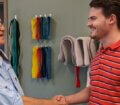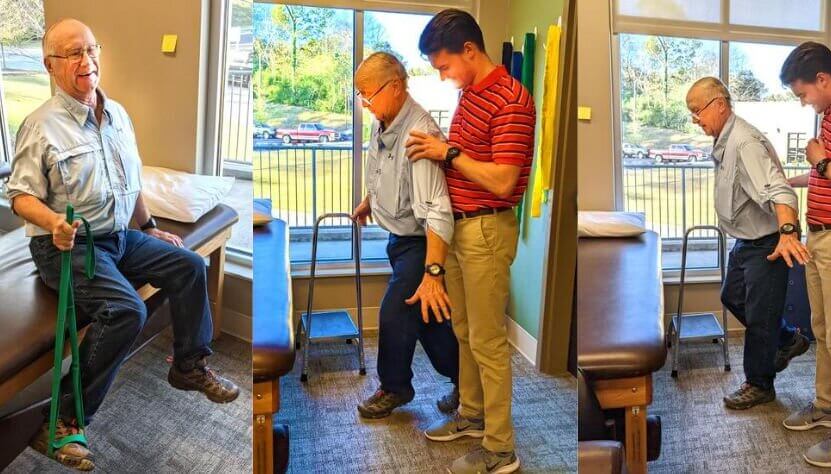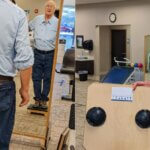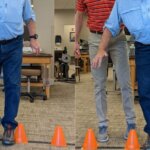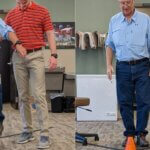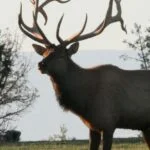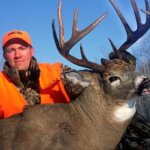All photos were taken by: Caroline Fischer
Editor’s Note: Balance is the key component to being able to:
- steady your rifle or your bow to make an accurate shot:
- keep from falling when you’re going up or down steep terrain or across rocky terrain;
- prevent a fall if you make a misstep in your tree stand.
Often many outdoorsmen have problems with balance because the muscles that are needed to maintain proper balance are rarely if ever strengthened. After I’d fallen twice – one was a hard fall – I assumed I had inner-ear trouble. I went to my family physician, and after checking me out, he sent me to a doctor who specialized in hearing and balance. After about two hours of testing, this doctor said, “John, from the waist up, you’re fine. You don’t have any hearing problems. However, from the waist down, you’re a wreck, and you need to see a physical therapist to improve your balance.” When I left his office, I wondered, “What does the waist down have to do with my falling?”
But since then, I’ve learned so much about falling and maintaining balance that I’ve never known before – although I took anatomy and kinesiology as part of my college curriculum. Here’s what I’ve learned that has helped me and may help you, if you have a balance problem, fall sometimes or can’t keep steady when you take a shot in the field. I spoke with Jacob Nichols, a physical therapist at Drayer Physical Therapy in Birmingham, Alabama.
John E. Phillips: What exercises have you had me do (correctly) to build strength in those muscles?
Jake Nichols: We start with an exercise called bridges that’s done on a table. This exercise helps to build-up the strength in the glutes, and then we activate the core muscles. We use the bridge exercise to give you a feeling for what those glutes are supposed to do when walking or standing. We then transfer that basic exercise to squats, step-ups and single-leg balance.
Phillips: In this exercise, you told me to make sure my back was flat on the table, next do a Kegel exercise – flex the muscles that turn your urine on and off when you go to the bathroom – and then tighten-up my glutes (butt muscles) in that sequence. Then after I’d gotten all three sets of muscles activated, I was to hold the bridge and then relax. Why?
Nichols: This retrains the core muscles on what they are supposed to do to stabilize your back, legs, knees and ankles.
Phillips: Tell me about the leg stretching with the green strap.
Nichols: We do this exercise by having you turn your leg and foot as far to the left and the right as you can. Then you use the green strap to pull your leg and foot somewhat a little further out away from your body, because we want to work on areas that passively pull the hip up. When we use the green strap, we’re activating the muscles in the hip to move the foot up as far as we can. The strap helps us get some extra movement in the hips. This exercise is what we call an active-assist exercise – extending and strengthening the range of motion at the hips.
Phillips: Why are we pulling the strap and exercising those internal muscles to pull the foot further to the left or the right and activate those internal hip muscles?
Nichols: Through testing, we noticed your internal rotation muscles also needed strengthening to help your balance. Often, if you don’t have strength in your glute muscles but have strength in your hips to keep you balanced, then you tend to tighten those muscles and get stiff in your joints. So, we’re getting added stability through that exercise. In other words, by strengthening those muscles, instead of your body strictly working on the joint, we are also wanting to strengthen the muscles around the joint. Then you’ll have more muscular stability that will prevent your falling and increase your stability when standing or walking.
Phillips: How does my standing on one leg help with my balance?
Nichols: The reason we want you to stand on one leg for an extended period (a count of 10) is because the glutes must stabilize the leg. When you’re walking, you’re standing on one leg – shifting your weight to the leg that touches the ground. Then the other leg comes up to take the step forward. Every time you walk, you’re standing on one leg each time you take a step before you take the next one. We know that this exercise of standing on one leg helps stabilize the leg and knee when you walk. We want you to be able to balance on one leg for as long as possible. Standing on one leg for 10 seconds activates your glute muscles. Then we can translate that exercise into helping your stability while walking. So, we do this exercise on the right leg. Then once we have completed three repetitions of 10, we move to the left leg and do three repetitions of 10.
What’s important about this exercise is that it is done in a safe environment. For instance, we have you standing in front of a table, so that if you start to fall forward, you have the table to stop you. We also have a chair on each of your sides, so you can catch yourself, if you start to fall left or right. When your muscles aren’t as strong as they need to be, you easily can tip over. We want to prevent falls on the left, the front and the right sides.
I’m also standing nearby, so if you do lose your balance, I can help stabilize you. I don’t recommend a person do this exercise at home. I want you to do this exercise in the clinic, where I’m standing close by. Then we’ve set-up an environment that’s as safe as possible, when you’re supporting all your weight on one leg. Once you go home from PT, we want you to think about how the muscles work to stabilize every step you take. You want to activate the glute muscles every time you’re shifting your weight to the leg that will touch the ground next.
Phillips: In other words, you want to bet on your butt muscles to help keep you from falling. Is that right?
Nichols: You’ve got it.
Tomorrow: How Wobble Boards and Step-Ups Help Deer Hunting

How to Hunt and Take Big Buck Deer on Small Properties
In this book, you’ll hear from 14 hunters who either have gained permission or leased properties as small as six acres to as much as 250 acres, and how they consistently take older-age-class bucks off these little lands.
VERSIONS: AUDIBLE, KINDLE & PRINT

Jim Crumley’s Secrets of Bowhunting Deer
Using a black magic marker and a gray work jumpsuit, Jim Crumley of Buchanan, Virginia, drastically changed the nature and purpose of hunting camouflage when he created the first sportsman’s camouflage – Trebark. Crumley’s love of bowhunting and his desire to be more invisible changed hunting clothing forever.
In this hunting guide, he shares the wisdom that he’s learned throughout his lifetime about how to be a hunter, how to find a deer lease, how to scout for deer, and more.
Special features include how to:
- Have a magic 60 acres to hunt
- Decide the best equipment to use
- Find deer year-round
- Locate land to hunt
- Know the best place to put your tree stand
- Get bucks within bow range
VERSIONS: AUDIBLE, KINDLE & PRINT

How to Hunt Deer Like a Pro
How do you know if the land you hunt has a trophy deer on it? Wildlife manager Bob Zaiglin, of Uvalde, Texas and Jim Crumley, the father of modern-day hunting camouflage, tells you how to find out. GPS can make finding and taking that trophy buck easier. This hunting guide will teach you how to hunt big bucks where no one else can find them, how to call deer, and how to become versatile as a deer hunter, so that if one deer tactic doesn’t work, another one will.
In the chapter, “How to find Bucks at Scrape,” Dr. Keith Causey, retired professor of Wildlife Science at Auburn University, describes the best way to hunt a scrape.
Brad Harrison of Neosho, Missouri, is a nationally-known videographer, professional deer hunter and master at calling deer. Another master is Will Primos of Primos Game Calls. These two experts will tell the best deer calls and when to use them in this book.
And for over 20 years, Bo Pitman, lodge manager of White Oak Plantation, has been studying deer movement patterns. He explains what types of conditions are best for predicting deer movement.
VERSIONS: AUDIBLE, KINDLE & PRINT

Deer hunting and deer hunters are drastically changing each year. To learn new techniques for hunting deer and have more places to hunt, I’ve interviewed some of the best deer hunters in the nation and share their tactics in How to Hunt Deer Like a Pro: Volume II.
In Chapter 10, Jacob Lamar tells you his tactics for consistently taking older-age-class bucks on public lands in several states. Chapter 11, Bob Walker explains how to find places on public lands where you can hunt that 99 percent of the other hunters never have considered hunting. The Bonus Chapter with David Ramey tells you how, where, when and with what equipment to take big Kansas bucks on public lands by hunting in 100-degree weather when others won’t hunt.
Chapter 13, Mark Drury, his family and his guests take mature bucks every season by having more small places to hunt rather than one large property. Drury explains the strategy of having satellite farms to hunt that only may be 50-150 acres each or less. Chapter 15, Pat Reeve, who hunts far-northern states and Canada, says, “I don’t like hunting for mature bucks until the weather is 20 degrees or less.” Chapter 4, Dr. Larry Marchinton says that funnels are the most-reliable stand sites to hunt for big bucks and tells why.
VERSIONS: AUDIBLE & PRINT
Expert Guidebooks on Elk Hunting: Best Sellers

Secrets for Hunting Elk
The quickest, easiest (if there is an easy way), and safest way to find and take that bull elk of a lifetime will be to hunt with a guide.
Chad Schearer, a longtime Montana guide and TV personality, told me, “My hunter is my gun. If I get to the elk, and my hunter isn’t with me, then we don’t take the elk. My job is not only to find the elk but also to help the hunter get to the elk and make the experience as enjoyable as I can for him.” That’s the kind of fella with whom I want to go elk hunting.
An elk hunt can be tough, but it doesn’t have to be so tough that you don’t enjoy it. That’s why this elk hunting book starts with the confessions of an elk guide and with Chad Schearer’s philosophy of what the guide and the hunter’s relationship should be.
A good portion of your success will depend on your physical condition, and Matt Morrett of Harrisburg, Pennsylvania explains how an eastern hunter can get ready physically during June and July to hunt western elk, the animals he describes as, “Like deer or turkeys on steroids.”
Wayne Carlton, well-known elk hunter and TV and video personality from Montrose, Colorado, tells us what types of elk calls to use and what to say to the elk. Mike Miller of Colorado, another elk guide and Mossy Oak video personality, has tactics for the best equipment for bowhunting and gun hunting elk.
You’ll learn helpful strategies and hunting tips in this book, as well as some straightforward hunting methods that will help to make your elk hunt more successful.
“Thanks to the advice in your elk hunting books, I was able to call up a nice 6-point (6X6) bull elk! He was bugling like crazy. I called him in from about a ¼ mile away. Called him into bow range (about 40 yards away). It was a thrill!” ~Rob Brannon
VERSIONS: AUDIBLE & KINDLE

Elk: Keys to 25 Hunters’ Success
Often just one tip or tactic makes the difference in whether you take an elk home to dinner or have to hike back to the truck by yourself. In John E. Phillips’ latest elk book, Elk: Keys to 25 Hunters’ Success, you’ll learn from successful elk hunters the strategies they use to find and take elk.
Many know that the technique that seems to work most often is to hunt where other elk hunters don’t and understand where the elk are before you go on a hunt by studying data from each state, visiting HuntData (see chapter 1), examining maps, and reading postings on elk forums.
This book also tells you how to get ready physically for an elk hunt, including participating in Train to Hunt Competitions, what gear you need to take, how to enjoy a successful do-it-yourself elk hunt, or how to pick the best elk guide for you. You’ll also hear about the X System and the Broken Y System of hunting elk.
Although no one person has all the answers on how to help you find and take your elk, I’m convinced that this book’s outdoors men and women will teach you how to have satisfying elk hunts.
As my friend Karl Badger once told me, “Elk hunting doesn’t get any better than when I ride horses into the high backcountry, see two grizzly bears, hear a pack of wolves howl close to camp all night long, eat plenty of delicious food prepared on a fire and enjoy the company of good friends.”
VERSIONS: AUDIBLE, KINDLE & PRINT

How to Find Your Elk and Get Him in Close will teach you the tactics of 10 nationally known elk hunters, to help put that giant bull that’s been screaming at you from afar, in your lap. You’ll learn what some of the best guides, outfitters, and successful elk hunters do to find elk and get them in really close.
Also in this audiobook, you’ll notice that the majority of the experts call elk to within bow range. We selected numerous bowhunters and bowhunting guides, since the bowhunter has to get much closer to a bull than the gun hunter does – often less than 20 or 30 yards – practically in your lap.
On one elk hunt, I’d heard this bull bugle all morning. My guide had called him within 30 yards, and he was standing just inside black timber. I saw the smoke from his nose wafting out into the icy air less than 30-yards away. All the bull had to do was step out, and I could take the shot with my bow. But then, through no fault of my guide or me, the bull vanished.
The only conclusion I could come up with to understand why the bull I wanted to take with my bow hadn’t stepped out and given me a shot, was because he got raptured. He evidently had left the earth with no trace of himself.
This hunt was when I started wanting to learn more about hunting elk up close. In this book, I’ve tried to find some of the most knowledgeable, experienced, and practical elk hunters. I’ve always found that the best way to learn any outdoor skill, is to either hunt or fish with the best sportsmen in that field.
Often, in elk hunting, that means elk guides, who generally hunt every day of the season and receive a salary for every hunter they guide. So, I’ve put together a group of some of the best elk hunters I know to help us all learn how to find bull elk and get them in close.
VERSIONS: AUDIBLE, KINDLE & PRINT

